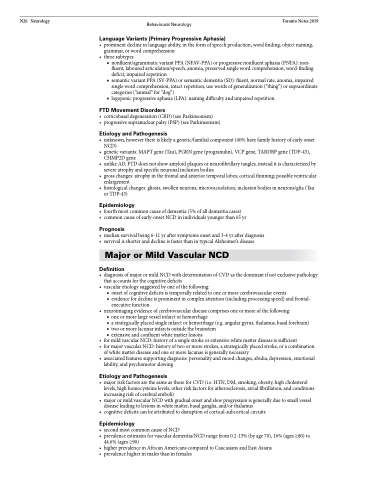Page 768 - TNFlipTest
P. 768
N26 Neurology
Behavioural Neurology Toronto Notes 2019
Language Variants (Primary Progressive Aphasia)
• prominentdeclineinlanguageability,intheformofspeechproduction,wordfinding,objectnaming, grammar, or word comprehension
• threesubtypes
■ nonfluent/agrammatic variant PPA (NFAV-PPA) or progressive nonfluent aphasia (PNFA): non-
fluent, laboured articulation/speech, anomia, preserved single word comprehension, word-finding
deficit, impaired repetition
■ semantic variant PPA (SV-PPA) or semantic dementia (SD): fluent, normal rate, anomia, impaired
single word comprehension, intact repetition, use words of generalization (“thing”) or supraordinate
categories (“animal” for “dog”)
■ logopenic progressive aphasia (LPA): naming difficulty and impaired repetition
FTD Movement Disorders
• corticobasaldegeneration(CBD)(seeParkinsonism)
• progressivesupranuclearpalsy(PSP)(seeParkinsonism)
Etiology and Pathogenesis
• unknown,howeverthereislikelyagenetic/familialcomponent(40%havefamilyhistoryofearlyonset NCD)
• geneticvariants:MAPTgene(Tau),PGRNgene(progranulin),VCPgene,TARDBPgene(TDP-43), CHMP2D gene
• unlikeAD,FTDdoesnotshowamyloidplaquesorneurofibrillarytangles,insteaditischaracterizedby severe atrophy and specific neuronal inclusion bodies
• grosschanges:atrophyinthefrontalandanteriortemporallobes;corticalthinning;possibleventricular enlargement
• histologicalchanges:gliosis,swollenneurons,microvacuolation,inclusionbodiesinneurons/glia(Tau or TDP-43)
Epidemiology
• fourthmostcommoncauseofdementia(5%ofalldementiacases)
• commoncauseofearly-onsetNCDinindividualsyoungerthan65yr
Prognosis
• mediansurvivalbeing6-11yraftersymptomsonsetand3-4yrafterdiagnosis • survivalisshorteranddeclineisfasterthanintypicalAlzheimer’sdisease
Major or Mild Vascular NCD
Definition
• diagnosisofmajorormildNCDwithdeterminationofCVDasthedominantifnotexclusivepathology that accounts for the cognitive deficits
• vascularetiologysuggestedbyoneofthefollowing:
■ onset of cognitive deficits is temporally related to one or more cerebrovascular events
■ evidence for decline is prominent in complex attention (including processing speed) and frontal-
executive function
• neuroimagingevidenceofcerebrovasculardiseasecomprisesoneormoreofthefollowing:
■ one or more large vessel infarct or hemorrhage
■ a strategically placed single infarct or hemorrhage (e.g. angular gyrus, thalamus, basal forebrain) ■ two or more lacunar infarcts outside the brainstem
■ extensive and confluent white matter lesions
• formildvascularNCD:historyofasinglestrokeorextensivewhitematterdiseaseissufficient
• formajorvascularNCD:historyoftwoormorestrokes,astrategicallyplacedstroke,oracombination
of white matter disease and one or more lacunae is generally necessary
• associatedfeaturessupportingdiagnosis:personalityandmoodchanges,abulia,depression,emotional
lability, and psychomotor slowing
Etiology and Pathogenesis
• majorriskfactorsarethesameasthoseforCVD(i.e.HTN,DM,smoking,obesity,highcholesterol levels, high homocysteine levels, other risk factors for atherosclerosis, atrial fibrillation, and conditions increasing risk of cerebral emboli)
• majorormildvascularNCDwithgradualonsetandslowprogressionisgenerallyduetosmallvessel disease leading to lesions in white matter, basal ganglia, and/or thalamus
• cognitivedeficitscanbeattributedtodisruptionofcortical-subcorticalcircuits
Epidemiology
• secondmostcommoncauseofNCD
• prevalenceestimatesforvasculardementia/NCDrangefrom0.2-13%(byage70),16%(ages≥80)to
44.6% (ages ≥90)
• higherprevalenceinAfricanAmericanscomparedtoCaucasiansandEastAsians
• prevalencehigherinmalesthaninfemales


